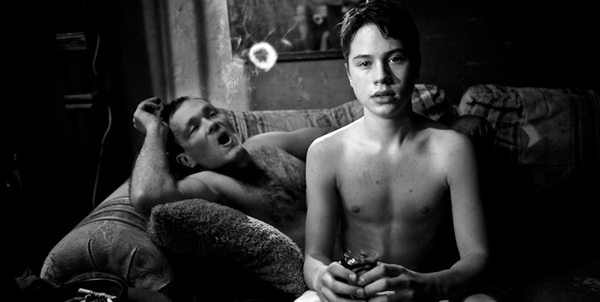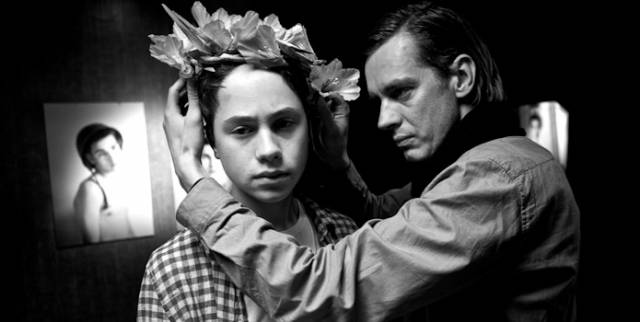
 Director Pirjo Honkasalo's Concrete Night takes place over the course of the day before Ilkka (Jari Virman) begins his prison sentence. Worried about her younger son Simo (Johannes Brotherus), their mother (Anneli Karppinen) asks Ilkka to spend his last day with him, showing him how to become "a man". Throughout the day in which Simo is to develop an identity, the brothers experience a Helsinki unlike anything else we've seen. Honkasalo's vision of the city is that of a noir hell, in which concrete structures cast shadows that conceal people's true purposes.
Director Pirjo Honkasalo's Concrete Night takes place over the course of the day before Ilkka (Jari Virman) begins his prison sentence. Worried about her younger son Simo (Johannes Brotherus), their mother (Anneli Karppinen) asks Ilkka to spend his last day with him, showing him how to become "a man". Throughout the day in which Simo is to develop an identity, the brothers experience a Helsinki unlike anything else we've seen. Honkasalo's vision of the city is that of a noir hell, in which concrete structures cast shadows that conceal people's true purposes.
Concrete Night made its debut at the 2013 Toronto International Film Festival and is now Finland's official submission for the Academy Awards. We talked to director Honkasalo about the film's aesthetics, discovering Brotherus and the film's unique use of music.
The first scene is a dream sequence involving water, and without giving too much away, I have to say it reminded me of Fellini 8 ½, would you say that was one of your influences?
Not directly, but you don’t know what’s in your head really (laughs). Of course I’ve seen that a film, a long time ago, and I didn’t really think about it making this one, but I guess it lives somewhere in my subconscious, and you don’t really know why it comes out of you.
There’s also a theme of reflection we see in the way the characters see themselves in water, glass, mirrors...which made me think of film noir as well.
I don’t think in those terms, when I start making a film and think about the look I’ll give it, I don’t look at any other films, but of course all the films I have seen live in me somewhere, but I try to avoid consciously being influenced by them. After the film premiered in Toronto, the first question someone asked at the Q&A was, "why is there so much water?" (Laughs) My answer was that because we are 90% water. I don’t think having water in my film is original, it all depends on what you express with it and how you deal with it, and every director has a different angle to it. The mirrors come from the novel, and something you can’t express directly in the film, was that at the beginning of the novel there is a dream as well, in which Simo looks in a mirror and he realizes that he doesn’t have a face, so he thinks that a face isn’t something given to him at birth, but something he has to earn, and something you have to make yourself, which is what the film is about: how to gain your identity.

Your partner Pirkko Saisio wrote the book and co-wrote the screenplay with you, since you’re both so familiar with the novel, did this make the adaptation process easier or harder?
Actually, I don’t think you can make an adaptation of a novel, because in a novel you play with language and other than the dialogues, in film you use images and sounds to express something, which is totally different. So even if the film is based on the novel I felt completely free to use the cinematic language, and one reason why I thought the novel would be a good base for a film was because the story is very simple. The book is 180 pages long, so it gives room to make a film. Very often directors pick epic novels and there’s so many climaxes and deaths and births...but this novel gave me air and the possibility to make a film. The basic story comes from the novel of course, but how I give it meaning is cinema.
You’ve made films based on poems before, would you say your process of turning words into cinema can be called “poetic images”?
Yes, I consider film to be much closer to poetry and music than to drama.
You’ve mentioned that part of what drew you to make this film was that you didn’t remember much of your own childhood and were trying to reconstruct your memories. Can you elaborate on that?
It’s true. I’ve made several films in over twenty years and I wondered why was I putting so many children between 12-14 years of age in my films, so afterwards I noticed I dealt with that age a lot and realized there’s a gap in my memory, I hardly remember anything that happened to me when I was that age. I remember thing after 14 when I had an identity, but it’s a complicated period because you’re not a kid, but you don’t belong in the grown up world either, so you’re kind of waiting in space.
This sense of limbo is presented to us by the fact that the film takes place the day before the protagonist’s brother goes to prison, and the plot is essentially about someone having a soul and then losing it. Is this your spiritual worldview?
I think you can’t avoid putting yourself in your own film (laughs), because you only understand of the world what you see in yourself, the rest you don’t understand. What happened to the main character obviously hasn’t happened to me, but he is building himself and he chooses violence. It made me wonder how I built my identity, because this age is dangerous, everything that happens to you defines who you are.
 The acts of violence we see in the film are committed against artists.
The acts of violence we see in the film are committed against artists.
I think it’s because Simo’s home is like a prison, her doesn’t have many choices. His home has no aesthetics, which I consider to be the most beautiful language people have invented, there’s no hope or a sense of beauty in his home either, so this artist he meets is frightening and at the same time is also the hole in the wall of his prison. He shows him something he has never seen before, perhaps this hole offers him an escape, as he’s exposed to aesthetics, but it also creates a lot of fear.
I thought it was interesting because it also brings up the fact that some old fashioned views of masculinity ask that men renounce artistic sensibilities, and ask that they choose a path of toughness and violence. Is this something you think still rings true to society?
Yes, 20 years ago for example, I thought that the Western world would achieve tolerance, and now suddenly we’re living in a world where this isn’t obvious anymore. It’s almost as if we have turned to the other direction. There is more and more intolerance, mainly because we are insecure and afraid.
This is why I find it remarkable that you cast Johannes because of how he reacted to a piece of music, instead of going for a more traditional process. It’s as if you chose him because he embraced what Simo ended up fearing.
I agree (laughs).
Can you talk about how you chose the music you used in the film? The Handel pieces in particular.
Good question. Now I have to think (laughs) I think this recording just came like a lightning in my head. I knew I needed to use it the "Il pianto di Maria" piece for a specific scene, and chose this version sung by Swedish opera singer Anne Sofie von Otter because she sings it without any sentimentality. It’s beautiful music and she sings it without mercy. Other singers do it in a very sentimental way.
I’m curious about the photographs in the film because they made me think of Caravaggio.
I had seen these photographs about twenty years ago and they’re quite impressive, because the boys in the pictures are normal Italian boys, they were inspired by this wonderful photographer called Wilhelm von Gloeden
How do you feel about the fact that your film is Finland’s official Oscar submission?
It’s fun and even an honor, but the crazy thing about the Oscar submission is that as far I understand, it’s very hard for a film to get nominated if it’s not known beforehand. I was talking to some people who said that to vote they only needed to see 18 films, so they would never have time to see all the submissions. It’s a little bit strangely organized if you ask me, it would be wonderful if Academy members had the chance to see the film, but anyway just being here brings new contacts, and I’m in Venice Beach having fun. What more can I ask for? It’s great being here.